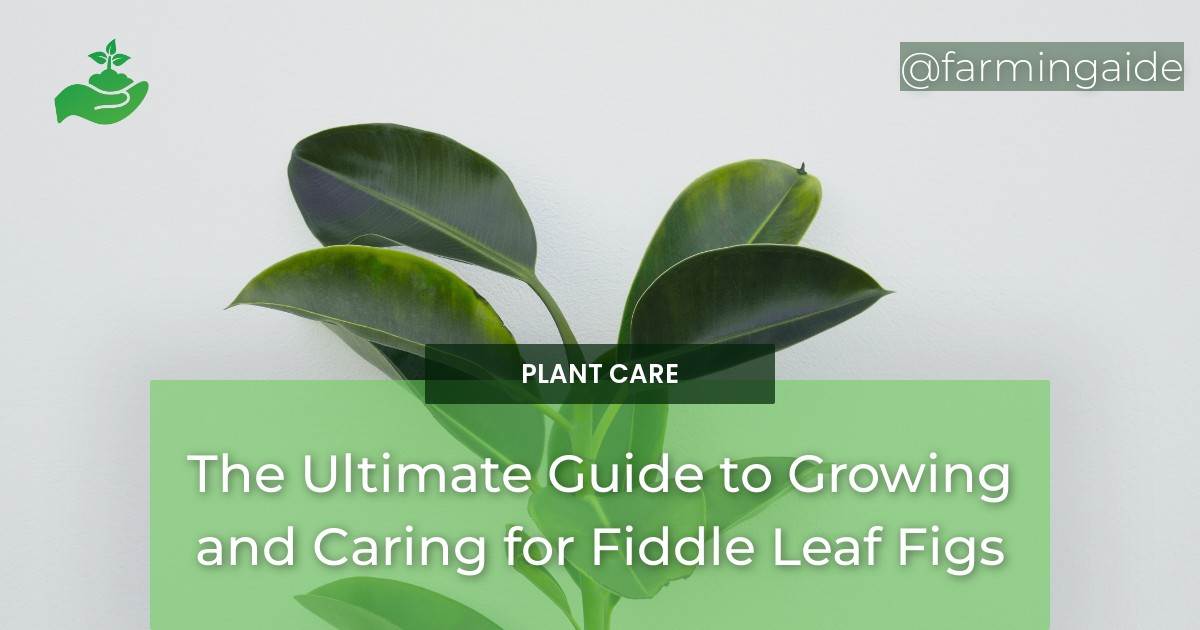Fiddle leaf figs have become a popular choice for indoor plants among urban farmers and horticulture enthusiasts. These beautiful and elegant trees not only add a touch of greenery to any space, but they also have a reputation for being relatively easy to care for. However, like any plant, fiddle leaf figs require proper care and cultivation to thrive and reach their full potential. In this comprehensive guide, we will explore everything you need to know about growing and caring for fiddle leaf figs, from choosing a healthy tree to sustainable gardening practices. So, whether you’re a seasoned gardener or just starting out, this article will provide you with all the information you need to successfully grow and care for your fiddle leaf figs.
Choosing a Healthy Fiddle Leaf Fig Tree
When it comes to selecting a fiddle leaf fig tree, there are a few key factors to consider. First and foremost, you want to make sure you are purchasing a healthy tree that has the best chance of thriving in your care. Look for these signs of a healthy fiddle leaf fig tree:
- Full, vibrant leaves with no discoloration or spots
- Strong, sturdy trunk and branches
- No signs of pests or diseases
It’s also important to consider where you are buying your fiddle leaf fig tree from. Local nurseries and reputable online retailers are good options, as they often have a variety of healthy trees to choose from. Avoid purchasing from big box stores or street vendors, as their trees may not have been properly cared for.
Optimal Growing Conditions
Fiddle leaf figs thrive in warm, humid climates with plenty of bright, indirect light. They prefer a consistent temperature between 60-75°F and do not do well in drafty or cold environments. When it comes to lighting, fiddle leaf figs need bright, indirect light to grow and thrive. They can also tolerate some direct sunlight, but too much can cause their leaves to burn.
When it comes to soil, fiddle leaf figs prefer a well-draining mix that is slightly acidic with a pH level between 6.0-6.5. You can use a general potting mix or create your own by combining equal parts peat moss, perlite, and compost. It’s also important to water and fertilize your fiddle leaf figs regularly to ensure they have the nutrients they need to grow. Water when the top inch of soil is dry and fertilize once a month during the growing season with a balanced fertilizer.
Planting and Transplanting Fiddle Leaf Figs
If you are planting your fiddle leaf fig in a container, make sure it has good drainage and is at least 2-3 inches larger than the root ball of your tree. When planting in the ground, choose a spot with well-draining soil and enough space for the tree to grow to its full potential. When transplanting a fiddle leaf fig, be sure to do so in the spring or summer when the tree is actively growing. Gently loosen the roots and replant in a larger container or in the ground, making sure to water thoroughly.
Soil Management and Composting
Good soil is essential for the health and growth of fiddle leaf figs. You can improve the quality of your soil by adding organic amendments such as compost, worm castings, or aged manure. These amendments provide essential nutrients and improve soil structure, allowing for better drainage and aeration. You can also create your own compost using kitchen scraps and yard waste, which is a great way to reduce waste and provide your fiddle leaf figs with a nutrient-rich soil amendment.
Pest and Disease Control
Like any plant, fiddle leaf figs are susceptible to pests and diseases. Some common pests that may affect your tree include spider mites, mealybugs, and scale insects. To control these pests, you can use organic methods such as neem oil or insecticidal soap. It’s also important to regularly inspect your tree for any signs of disease, such as leaf spots or wilting. If you notice any issues, it’s best to address them immediately to prevent further damage to your tree.
Sustainable Gardening Practices for Fiddle Leaf Figs
In today’s world, sustainability is becoming increasingly important in all aspects of life, including gardening. When it comes to fiddle leaf figs, there are a few simple tips you can follow to make your gardening practices more sustainable:
- Use organic fertilizers and pest control methods
- Choose native plants and companion plants to promote biodiversity
- Reduce waste by composting and reusing materials
Seasonal Planning and Crop Rotation
Understanding the growth cycle of fiddle leaf figs is important for planning and maintaining a healthy garden. These trees typically grow and produce fruit in the spring and summer, and go dormant in the fall and winter. It’s also important to rotate your crops to prevent nutrient depletion in the soil and reduce the risk of pests and diseases. Plan ahead and rotate your fiddle leaf figs with other plants that have different nutrient needs to maintain soil health and maximize yield.
Can the tips for propagating poinsettias also be used for fiddle leaf figs?
Yes, the stepbystep poinsettia propagation tutorial can be used for fiddle leaf figs as well. Both plants can be propagated using similar methods such as stem cuttings and rooting hormone. The key is to provide the right conditions of warmth, moisture, and proper sunlight for successful propagation.
Conclusion
In conclusion, fiddle leaf figs are a popular choice for indoor plants due to their beauty and relatively easy care. However, to ensure your fiddle leaf figs reach their full potential, it’s important to choose a healthy tree, provide optimal growing conditions, and practice sustainable gardening methods. By following the tips and information provided in this guide, you can successfully grow and care for your fiddle leaf figs and enjoy their beauty for years to come.


